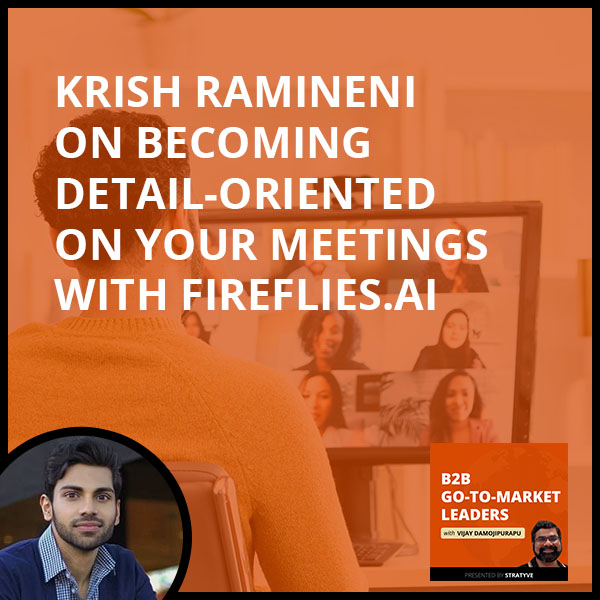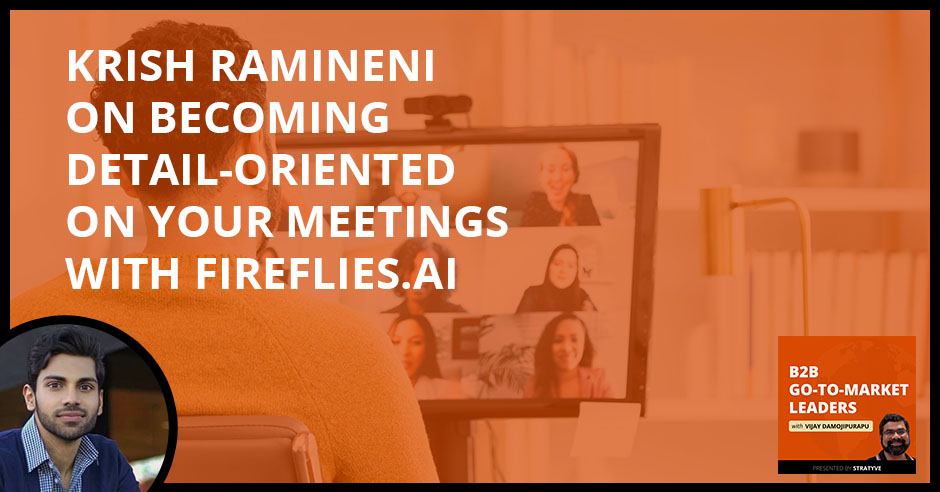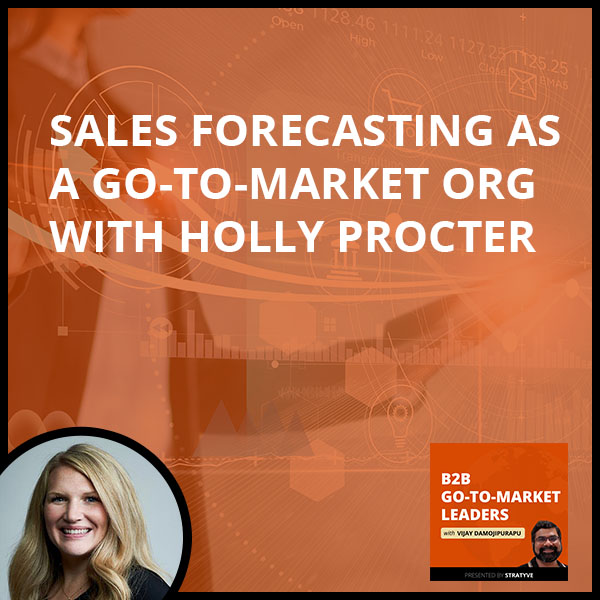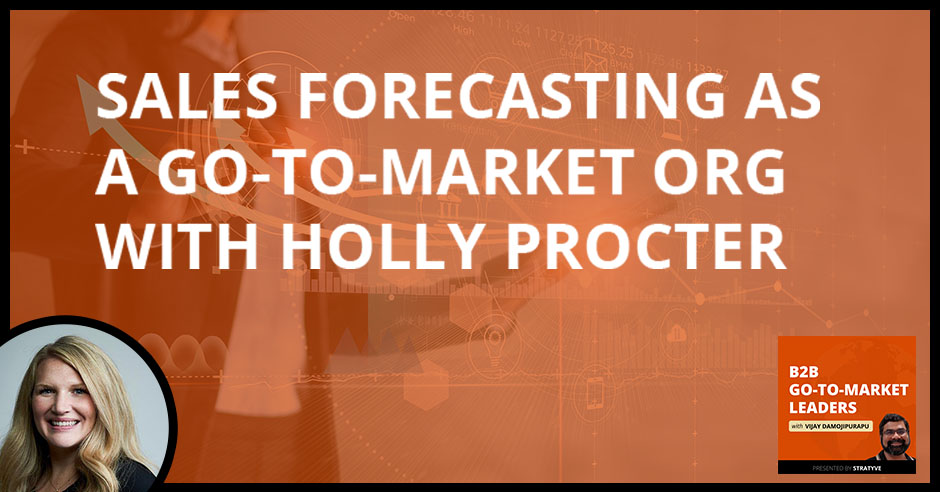

With the prevalence of Zoom and other video meeting programs, it is much harder to remain detail-oriented, take notes, and pay attention to lengthy digital discussions. If you’re struggling with that, Fireflies.ai is your best answer. This AI meeting assistant joins your meetings to take notes, transcribe verbal data, analyze conversations, and a lot more. If you want to rewind and go back to your meetings because you forgot something, you can simply check in with Fireflies.
Join Vijay Damojipurapu as he talks to the Co-founder and CEO of Fireflies.ai, Krish Ramineni. Learn how he implemented NLP technology to create this AI-powered tool. Discover more information about its features and how Krish and his team spread Fireflies through word of mouth and product adoption. Check this episode out so you’ll never miss a single detail on your next meeting ever again!
—
Listen to the podcast here
Krish Ramineni On Becoming Detail-Oriented On Your Meetings With Fireflies.ai
I have the good fortune of hosting and speaking with Krish Ramineni, who is the Founder of Fireflies. I’m so looking forward to it. Krish is one of those Forbes 30 Under 30. He made it to that list. I’m sure you will be in for a treat as far as good market insights are concerned. With that, Krish, welcome to the show. How are you doing? It’s bright and sunny here in San Francisco Bay Area.
I’m doing great, Vijay. The weather is awesome. I haven’t had a chance to step out myself. This has been quite a busy day. There’s a lot of exciting stuff here at Fireflies that we are working on. I’m doing well. Thanks for asking.
I always start my conversations with each and every guest with this question. How do you define and view go-to-market?
Go-to-market, for me, is about helping people understand that a certain technology, product or service is available but sometimes, even before you talk about the product or service, you have to help them understand if there’s a need or a problem that they are trying to solve. Go-to-market for me starts with awareness and education.
It’s about users’ customers helping themselves acquire a piece of technology or product for their business in the most frictionless way possible. I believe that it’s about letting people buy the way that they want to. The best go-to-market strategies are the ones that are able to take away those barriers and help guide users, buyers or admins through that decision-making process in the most seamless way.
I can see your definition in line with the product-led growth phenomenon that’s taking the go-to-market world and the B2B world by storm of late. There are many flavors of go-to-market. Your definition aligns with product-led growth. I heard you mentioned users and buyers seeing value by themselves and then helping them make the decision where they can take their action, “I see the value, and I’m going to purchase this product.”
There was a time when I was on the extreme end and said, “No salespeople and marketers. It’s only going to be product-led.” The only way you were going to be able to purchase a solution like Fireflies was you are going to see it, try it, buy it, and swipe your credit card. That was going to be the only way. My definition has expanded over time because not every person or buyer follows the same model. Some need more handholding than others. Some have custom requirements.
It’s about understanding the user and what triggers them to make that purchasing decision or that a-ha moment for them. Similarly, when you build a product and are a startup, you are looking for people to get that a-ha moment from the product, saying, “This is great. This is magical. I want to use it.” Even in the buyer’s journey, a lot of times with GTM, people are bombarding you with emails and account-based marketing.

Sometimes the SDR function is also part of the go-to-market team. Our first default response now is to say no. We are not even open to the idea, saying, “Why? Yes. I’m curious.” it’s like, “Don’t bother me.” How do you pique someone’s interest and get them to that a-ha moment, whether it’s marketing or from a product lens? At certain times, you can’t do it all with the product. You will need to have people and conversations.
Tell the audience about why you came up with the name Fireflies. What does your company do? Who do you serve?
Fireflies is an AI meeting assistant. It joins your meetings across Zoom and other video-conferencing platforms. It takes notes, transcribes the meeting, analyzes those conversations, and creates a knowledge base for you to search back through. If I want to remember a conversation I had with you where we were talking about GTM, I can search for the word GTM in my conversation with Vijay, and I would be able to pull that information up in a minute. I want to be able to remember all my conversations and also not have to do busy work. Meetings are expensive. We want to help people be more productive during meetings.

That was our simple value prop for starting Fireflies. The name Fireflies has an interesting background. My Cofounder, Sam, and I met in college. We worked on various projects. Many of them had nothing to do with B2B SaaS. We worked on drones. One of the things we did was build a drone delivery system. At night when drones fly around dropping packages, they look like Fireflies. We used the name Fireflies and continued using that name for all of our different projects.
Lately, we have had customers come up with their interpretation or story of why we are called Fireflies. One of the things that they came up with, which was very creative, was, “Fireflies is this silent fly on the wall in a meeting that sits and takes notes.” That’s a common idiomatic phrase. Another person said, “Fireflies is very interesting because usually, all of these conversations are hidden and buried after you leave a meeting. Fireflies is lighting up all of these conversations that are happening across an organization.” I give credit to our customers for it but we are running with that narrative for why we are using the name Fireflies.
That’s a very interesting story. The backstory there is around the drone using that in the night, and then you gave the name Fireflies. Something that is popping up when you are sharing those customer stories is that they see value in the product. It’s almost like, “I love the product. How do I give my interpretation or the version of that brand name when I’m using the product?”
Every person has a different way to describe Fireflies. When we get on customer testimonial meetings or interviews, a lot of times, people will see Fireflies in a meeting. When someone asks, “What is that thing you are using?” they will talk about it. They are saying what the solution is. It’s cool to come after hundreds of thousands of conversations.
There are 3 or 4 common ways people describe it to them, “It’s my personal assistant. It’s my note-taker. It helps me stay on top of things.” For our marketing too, let’s use these phrases because almost everyone seems to be using the same theme. Sometimes the best marketing is customer word of mouth. We do see those common things showing up.
The best marketing is customer word of mouth. Share on XOn a lighter note, what is your parents’ interpretation of what you do at work? How do they see that?
For them, it’s about me. Once, I was a Product Manager at Microsoft. I was working at a tech company, going and playing the game of a startup, and trying to be my own boss. That’s something that they see in the early days. A lot of people are like, “Why would you leave a nice comfortable job and do these things?” Over time, they have realized. I’ve even had my dad or other folks who work in tech seeing Fireflies in their meetings at their companies. When people you know, close family, and friends see it, it’s like, “I know this. I know who works on it.” That’s a game-changing feeling. They believe that I’m on a mission to make meetings better. That’s exciting.
There’s nothing like when your parents see and use the product that you are building. That’s an amazing moment in life overall. You also mentioned your career journey so far briefly. You mentioned meeting your cofounder at the university. You went to Microsoft and were a Product Manager. What prompted you to start your company and why around the space?
Going back like most Asian American kids, I thought I wanted to be a doctor in college. I quickly switched over to the engineering side or the technology side of things. While I was doing that, I was never passionate about engineering the same way I was about solving problems, working on projects, and getting groups together. The way I learned to code, how the technology worked, and learned about databases was not in a classroom initially but was working with peers.
In my freshman summer after my first year of college, we worked on an app together, and that idea, “We didn’t have any real internships at that time. Why not make our internship? We need something on our resume.” It turned into this massive tool that we ended up building for college campuses back then. We ended up getting hundreds of other ambassadors to help us market the product. It was a consumer-like product but was great because that was around social media time. It was exciting.
That got me thinking. Most people are using maybe 10% to 20% of the computer science skills that they are working on. There are few companies that are using deep tech or deep machine learning stuff. Technology is truly democratized. Anyone can start working on it. I was never afraid of how difficult a problem was going to be. You just start working on it. I had a lot of fun throughout college. I worked on several other projects. I did hackathons.
The way I met my cofounder he went to MIT. I went to UPenn. We met through mutual friends. My cofounder and I had never met in person for the first two years. We met on a video call. Every evening after our classes or problem sets were done, we would work on different projects and submit them. You win little prize money or awards for submitting to these hackathons. We competed in a lot of hackathons. I remember the first hackathon we won. We got $1,000 or $1,200.
We said, “Let’s take this money and then build some more apps. Maybe we can hire some freelancers to help us market or do other things with it.” That was the entrepreneurial journey. After I graduated college, I ended up graduating a year early. My cofounder was still in school at the time. I went off to Microsoft and learned a lot there. The discipline it takes to build enterprise software is very different. Here we were, kids hacking on a few things.
I got the perspective from both worlds of what it means to be fast, agile, and creative and then what it means to build software that businesses pay a lot of money for. The line is blurred from a technology point of view but from a go-to-market point of view, it’s different. You can take the same cool piece of technology, and someone is going to market it better than someone else. That could be the success point. That was the journey I ended up on. After my time at Microsoft, I reunited with my cofounder. I was there for a summer. I was supposed to go to graduate school but I had a summer off before that.
I went to Boston and stayed there for the summer. We started working on a couple of different ideas like hackathons and then said, “Why don’t we start a business, work on this for a few years, and see where it goes? We are not going to get an opportunity like this later on.” One thing led to another. We moved to San Francisco and incorporated the business. We went through 4 or 5 pivots and then landed on the voice space. That is the current version of Fireflies as it is.
Some of the traits or some of the stories that I’ve seen with successful founders is that they started working on a problem that they connected with. That turned into a startup. Was there a story around that for you and your Cofounder, Sam, where it was around recording transcription? “This is the new and emerging space. Let’s figure out and use AI to do something about it.” What is your thought process like?
It was a combination of both. We were fascinated by NLP technology. Everything we built early on was around how we understand text and conversations and help people be more effective. Honestly, our very first idea was, “I get 5,000 emails every day at Microsoft. Let’s build a tool that tells me which emails I need to prioritize.” It’s almost like Google PageRank for emails. For that, you understand what’s in the emails and rank it.
It’s a nifty productivity problem but maybe not a problem that someone is going to pay a lot of money for. That started as the initial project that we were thinking about, “How do I save more time because I can’t deal with emails?” A lot of people were out there building a brand-new emailing system. Our goal was not to build a new system but, “How do we take something that’s there and make it better or add new technology to it?”
Another idea we had in our journey for pivots and iterations is that I tend to do a lot of messaging over LinkedIn and different chat apps. I can’t remember all the promises I make to people. I use a bunch of different to-do lists but it’s very hard to keep track of who I’m talking to and what I’m saying. We built a Chrome extension that would track all the conversations I’m having with different people across different apps like Facebook Messenger, WhatsApp, Slack, and all these different apps.
Anytime I made a promise to someone saying, “I will send you the report next Friday. Let’s meet up next month,” it would automatically detect that using NLP and create a to-do list for me, “Here are all the tasks or promises you’ve made.” If someone promised to do something for me, it would also make all the tasks, pull out the dates and times, and set up automatic reminders for me.
If I had a chance to go and work on this project, I would because it’s fascinating. We even applied to YC with it. We got an interview day. It was an exciting project. However, for us, it’s a GTM thing like, “How do you now take this productivity prosumer-type tool and sell it to businesses or B2B? How do you make money on this? How do you monetize it?” That was a real challenge.
That’s why we took a pause on it but we took the same technology and learning and said, “There’s this huge blue ocean in terms of meetings.” For emails, I can at least go back and look at an email I sent two years ago. I can look at a chat message I sent two months ago but once I leave that meeting room with Vijay, I probably will not remember for one week what I discussed. I will not be able to recall that memory, “Let’s build a knowledge base of all of my meeting conversations and then run this NLP that shows me action items, dates, next steps, timelines, and deadlines.” That became what Fireflies is.
There are a lot of things to digest over there. You mentioned product-led growth. You gravitated toward product-led growth from the early days. Is it fair to say that you added on a sales-led motion more recently after product-led growth?
We are working on the sales-led motion as we speak. The way we look at our sales team is that we call them customer onboarding managers. We believe that as people come in, they are aware of the technology or interested in the technology. How can we help guide them through that process? What you would see typically in pre-sales is a fusion of customer success and sales because many of them are not starting from zero. They are starting with some knowledge of the platform.
We found that there are certain types of customers that need to turn on specific integrations or they have specific questions that they won’t be able to get answers to in the self-service. The majority of our customers, whether it’s a 1-person team or a 5,000-person team, can theoretically sign up, add teammates, build-out, and pay for it at a large org level without ever talking to sales.
I believe in the Atlassian go-to-market model. Zapier has a fantastic go-to-market model. Calendly had a fantastic go-to-market model. However, when we are building collaboration software, there are going to be different things that we need to go through. People have security questions. They want to know about our compliance stuff. We do a lot of work there as well. We want to be an enterprise-grade product that can be as easy to purchase and use as a consumer product.
Somewhere along the way, you realize that you need people there for those that need help. It’s less about us spamming people with emails and doing outbound. It’s more about how we build that inbound funnel and use the product-led leads. Maybe if there’s someone that is at the right stage to potentially purchase or upgrade, and they are from a high-value account, we should probably give them more attention and more of a white glove service. That’s where we have the salespeople.
Selling is less about spamming people with emails and more about building an inbound funnel. Share on XThere are two tracks that come to my mind. I would love to dig deeper into both tracks. The first is with PLG. It’s all about how can your target users find your product and self-onboard and how quickly can they see the value. It’s all about that. That’s one component. The adjacent component and critical part is the virality because that will reduce the CAC for you. At the same time, it shapes or translates to growth on its own. That’s the first track. Keep that in mind.
The second track is the PQLs or Product-Qualified Leads, which is the sales assist model you are talking about. Let’s deep dive into the first track. In theory, it all sounds wonderful. I was brought in to build a PLG at a Series B startup. We went down that path but it’s super hard. In theory, it boils into three steps. One is how you get users to find the product. The second is self-onboarding. The third is finding value and virality. Those are the 3 or 4 steps in theory. It’s easy but it’s hard to execute in the real world. Help the readers understand the challenges that you ran into early on. How did you work around those?
We were able to build a critical mass of initial users that were able to bring Fireflies to more meetings. That was the triggering point for virality. I will start with the first point, self-service. A lot of people can even experience Fireflies before they even sign up. They can see the bot in the meeting. They will have a conversation. Word of mouth is probably our number one thing. People talk about it. Firefly sends a meeting recap afterward the meeting to the people.
When it does that, they are able to view the transcript and the notes. They are like, “This is great.” We have a thing saying, “Sign up and start using it.” That’s where we get most of our growth. We don’t spend money on other channels like advertising or ads. It’s word of mouth and direct search traffic. It’s a result of word of mouth or seeing it in a meeting and saying, “What is Fireflies.ai?” Luckily, our domain name is the same as our company name. People tend to see that and talk about it.
We had a customer of ours who said, “I saw more Fireflies than I sell my SaaS software because I talk about it so often,” which is fantastic. A lot of times, people are going to be able to see and use it. We now have a free trial as well as a freemium function for the product. You get full access to freemium, where you have limited transcription, credits, and storage. Usually, people will hit certain paywalls and decide to convert on their own or go through the full free trial, get a lot of questions answered, and convert that way.
Through this process, we will also see some people who are like, “I see this. I want to sign up for it but before I sign up, I need to think about how I deploy this to an org. I need more of those IT-level questions answered.” They will request a demo. Usually, when we ask them, “How did you hear about it?” it’s like, “So-and-so told me. I saw it at a meeting. I’ve heard about this. This is exciting. I want to check it out for myself and see it to believe it.” That’s the motion.
We also have PLG. This is probably still the hardest one. A lot of people put very interesting flavors on PLG, “You are going to have a customer. They are going to respond back to you.” To be honest, many PLG people don’t want to talk, “Let me buy on my own. Don’t bother me. I might buy it for myself or a few folks but I’m not going to go and do an org-wide deployment. You are talking to the wrong person. I’m not the person that’s going to buy for my entire org.”

For PLG, you can do all the work but you have to not bother the wrong type of users. Maybe as you have people inside a particular domain start using it, you start doing org mapping. You have to do traditional account-based marketing. We are still figuring that out. That’s hard even for Series B, Series C, and later-stage companies. It’s not as easy as it is for other companies or how other companies make it seem.
I’m sure even for Slack, who are some of the greatest proponents of PLG, it took a long time for them to map out, “There’s a small group of people in this company using Slack. How do I get their IT admin to deploy Slack to everyone?” That’s a sales challenge on its own. PLG can give you leads but that doesn’t necessarily mean those leads are going to be the decision-makers in an enterprise org.
Product-led growth can give you a lead. But that doesn't mean those leads are going to be the decision-makers in an enterprise. Share on X
That’s where I do think there is a fundamental challenge. It’s not as easy as investors or other people make it out to be, “PLG is beautiful. It reduces your CAC. You are going to get all this.” One thing we have done well is self-service and the revenue we get from users’ businesses that way but to do enterprise-wide deployments, selling the department is one challenge. Selling to an enterprise org that’s where maybe you will need a sales GTM function. The PLG is a way for you to show them, “We have an in. There’s some value here,” but you still need to have effective ways to have those conversations.
This is a good segue because I ask each and every guest of ours or whoever comes on the show for them to share a GTM success story and a GTM failure story. It’s your choice. You can pick either a success or a failure. I would love to get your thoughts and personal experiences from those.
There are general ones I’ve talked about where we have seen the virality work, and these things work. With GTM failure, there are a lot of enterprise-based companies. They will put fancy names on the existing technology and say, “This is insights. This is going to tell you all of this stuff.” They will take the core technology features and functionality and put layers of stuff. They will call it revenue intelligence, deal intelligence or some of these fancy words for basic stuff like analytics.
What we have found is that it works when you have salespeople selling and selling that sauce but it doesn’t work when you have a self-service PLG motion where people are like, “Say what it is and how it works. I don’t want you to use crazy acronyms or special words.” That works when you have a great sales team, and you can sell on the narrative but we found that it’s much more effective to be able to say exactly what the technology does and simplify what you can do with that technology and the basic features. That has a way more success rate for us at the type of customers we are targeting at the PLG level.
We try to do traditional B2B marketing where you will go through the entire website and a few pages, and you are like, “I don’t even know what their product is.” They are promising all these benefits and then saying, “Talk to sales,” but I have no idea what this product is. When we tried some of those experiments in the early days, it was not effective. It didn’t pique people’s curiosity as much as, “Let me show you, not tell you.” That was something I noticed.
If you can share the success story and the early days of Fireflies, that would be great.
2019 was when we first started working on the alpha version of Fireflies. Later at the end of 2019, we raised our first seed round and then kept working. We got into the beta. We did a broader rollout in January 2020. A few months later, the pandemic happened. All hell broke loose. It was crazy. These technologies were becoming more front and center. Everyone was spending time on video conferencing. We built Fireflies for a world where it was going to be hybrid for in-person as well as remote. If it’s in person, it would join through a conference line.
We built it for that world but everyone went to video conferencing. We are this fledgling startup. This is starting to pick up and take off. We have to build the platform for scale. You can’t glue things together. We were fortunate after our seed round in the last couple of months of 2019 to rebuild our entire architecture from scratch. Otherwise, we wouldn’t have been able to handle the incoming demand that was coming in 2020. We kept scaling up.
Before you go to scaling up, how did you get the word out that there’s this product named Fireflies? Who was the initial audience?
We launched to a handful of folks in our network, our friends, and maybe 200 people. We had a waitlist of a couple of thousand people. We didn’t have this million-person waitlist like some of these other companies. Those people were originally the drivers. There was zero spending on marketing. In the early days, we gave a lot upfront of transcription credits and stuff. We encouraged people to share Fireflies. There was also that word of mouth and showing up in meetings.
Did you send out emails, drive people to a landing page, and say, “I’m interested. Add me to the waiting list?” Is that how it does?
We had a ranked waitlist where if you share with more friends, you go up the waitlist. We tried that strategy as well. We did product hunts. We did a lot of outreach, launches, and relaunches. Every time we had a new video conferencing platform, we supported it, “We now support Zoom. We are now supporting Google Meet.” We would do an announcement about that. There were a lot of announcements for new things that we did when we had a new CRM integration.
Every integration connection was a new announcement. Every integration we built was an announcement. We knew that this was starting to work when other people started to bring their Fireflies into meetings with us. You start to see it full circle. We could track in the early days when we had our initial customers here in San Francisco, California Bay Area. They would have a meeting with a customer in Atlanta, Georgia. We said, “Why are we blowing up in Atlanta, Georgia? Why are there so many other companies using it?”
Those people brought it back to people in the Pacific, Northwest, and Seattle. That person brought it back to the original user, which was in San Francisco, California. We started to see that flywheel. It’s a firefly hopping around the map. That was something that we thought was very cool. It sounds like there’s some crazy magical thing that we had to do but we built virality into the product. We incentivized sharing and people to talk about Fireflies and share the recaps and all of that.

Was it a freemium or a free trial?
Initially, in a good part of 2020, we didn’t even charge. Until we started seeing traction, we didn’t even charge for the product.
For the entire duration of 2020, it was all about product adoption.
For the greater part of 2020, it was all about product adoption. It was only in the later part of 2020 that we started monetizing.
Can you share some stories about the pricing? What did you think about the pricing? Who were the initial set of folks you would go to pitch and test the pricing? What is that like?
There were a couple of suggestions from folks and advice that other people gave. One was, “Go to enterprises or mid-market, charge $20,000 to $30,000, and sell it like a sweet solution.” We didn’t feel like that would fit with our model. It’s a great way to get quick revenue but you are going to tap out after 10 to 20 deals. You are going to have to hire more salespeople and do all of that.
The best advice they say is, “Close a bunch of deals yourself,” which I’ve done before we hired other comms people but that is if you are doing a sales-led company. Instead, we said, “Success is going to be if we can get to some amount of revenue where we never even have to talk to the person, and they are purchasing on their own. That is success for us. That is the Holy Grail or North Star for our SaaS.”
Success is getting revenue without even having to talk to a customer to buy your product. Share on XWe started looking at different pricing options. One was, “Do we price by utility? How much do you use it?” We realized a lot of people don’t want to worry so much about transcription, “I can’t use it in these many meetings or that many meetings.” We don’t want it to feel like AWS because AWS is great for developer products but it’s not great if you are buying SaaS solutions.
People want à la carte, “I buy ones. I can consume as much as I want. I want a buffet.” We were one of the first people in the industry to do that, and we made it unlimited usage. You can pay one price per seat. We started experimenting with seats. Initially, there were a lot of individuals paying for Fireflies. Over time, we said, “Fireflies is great as an individual product but how can we make it even better as a team product and a multiplayer product?” We realized there’s a lot of value in creating a team product.
Even Calendly, in the early days, was a single-player product. For the most part, it is a single-player product but they have come up with some creative ways or added certain things. A lot of times, for many companies, a multiplayer product has admin controls, admin access, admin safeguards, and stuff like that. For us, there’s inherent value if you have a workspace with your sales meetings, teammate sales meetings, and HR meetings all in one central place. We are building a living, breathing, and self-updating knowledge base or workspace. That is magical.
I’m looking at your pricing page. It was $0. It’s free forever. You have Pro, which is $10 per seat per month. The Business is $19 per seat per month. Was this the price that you launched with? Was this something that you iterated? Clearly, it has to be the second one. How did it evolve to this?
Surprisingly, this is the pricing we started with. We got lucky there. We had a gut instinct. There are a lot of people that say, “Why are you making it so affordable when your competitors are charging $100, $200 or $120 per seat?” I know some of the competitors in the revenue intelligence space. I wouldn’t say competitors because we also focus on a diverse set of personas. We are not just sales. We want every person inside an organization to use it. They are charging $120 per seat. Plus, they have an implementation fee. You must pay $10,000 to $20,000 to get the platform set up.
Why are you not charging that level when you are offering powerful technology that’s 90% of everything that’s there, plus some other stuff? We had in the early days four tiers. That’s one thing I do remember. Early, we had 4 tiers and simplified it down to 3 tiers. The other tier was where it was an audio-only tier where you got more storage but then we realized, “Let’s keep it to three tiers and make it available.” It was easier for people to decide.
How would you define your ICP? How did that evolve from day one?
This is the hard part because we have many different personas and industries. If you were to ask Dropbox or Calendly what their ICP is, it’s very difficult or even Zoom, for that matter. We believe our general umbrella is that any knowledge worker that has meetings in the corporate space is very important to us. There are different types of meetings. There are internal meetings like operational meetings that you have. There are customer-client-facing meetings. You have candidate-based meetings. I look at it as the four Cs. Your Customers, Candidates, and Colleagues all form your Company.

That’s how I think about it. In any conversation that’s happening, the voice of your organization is what Fireflies is helping you capture and build a knowledge base around. Instead of comparing to other AI tools out there, let’s look at what great knowledge management tools of the past were and now are. You look at SharePoint. Every enterprise has SharePoint. It was a fantastic tool back then. You have other wiki software. Atlassian has its wiki software.
There are so many of these different wiki software but the problem is whether I’m using Google Docs, Google Drive or Dropbox, all those documents will end up getting stale if I don’t update them. If someone is not updating those articles or help desk stuff. Whereas with Fireflies, every conversation is automatically updating your knowledge base. I don’t have to manually update it.
Years ago, we had a very different conversation about pricing and how we should charge customers. After all our learnings, we have another thought process around pricing and how we should charge. If a new person is hired, and we never updated that knowledge base from years ago, they are going to onboard with the wrong mindset. That is very expensive to untrain and retrain, whereas if they are using Fireflies, they now are able to get up to speed.
We also use Fireflies almost as an LMS where when we have new people that are onboarded, we say, “Listen to these Fireflies recaps on our best sales calls. Listen to these on what to ask the candidate when you are interviewing them. If you are a first-time manager, this is what you should be asking for. This is why we made an important architectural decision. You asked about why we are using this technology. You are getting onboarded into the code base, so go ahead and take a look at all of this stuff.” I don’t have to ever repeat myself. I say it once. It’s equivalent to me saying it a thousand times in a way, which is funny. That’s the one thing that helps all of our teammates.
That’s a very interesting use case. Typically, when we talk about recording meetings, it’s mostly in the context of customer sales and sales coaching but what I’m hearing based on what you are sharing here is that it’s almost like an internal LMS or Learning Management System. These meetings happened. As an example, I want to understand why the scaling and architecture changed. I type that in, and it’s all there versus having to talk to people or even worse, not knowing who to talk to in the first place.
The best part is that we want you to be able to consume that data without having to sit and listen to the entire 30-minute or 40-minute meeting. You can look for the word integration or architecture, jump to that point in the call, and listen to that snippet or soundbite. If I had great feedback or customer input that came in through this meeting, I will highlight that 30-second clip created into a soundbite and share it with the team. How can we help you consume and get knowledge in 5 minutes instead of 50 minutes of listening to that call or reading a 50-page transcript?
It looks like you got that early traction. You are looking to scale. What are the different channels? For PLG, some of the popular channels are virality, word of mouth, referral, organic, inbound, SEO, and even paid. These are the popular channels or even affiliates. I’ve seen affiliates also coming up on the charts now. What are the channels that you are excited about and something you are exploring as you scale?
We are exploring other channels like affiliate and referral marketing because a lot of these people are saying, “I’m already referring Fireflies to so many people. Can you have some incentive where I get more transcription credits or get paid for that?” We are exploring that. This is coming from user-generated interests. We never had an idea of doing this but there are a lot of people that are willing to advocate and push Fireflies. We want to be able to push that.
There are people creating content about Fireflies. When I go on Twitter, they are like, “Here are the five best tools that I use for AI that help me be super productive.” They list Fireflies. How can we streamline and supercharge the customer conversations, the customer voice, and what customers are saying? One of the things we are exploring and still learning about is how we set up a great referral program for existing users that refer other users and then how we set up a great affiliate program for people that want to drive traffic to our website or convert and then get paid to do that.
I always believe that could be a great strategy. We also see interest from consulting firms and other types of folks that want to implement a solution like Fireflies at larger organizations. That has been less of our focus because we want to go direct to our customers but it is also something that we could potentially explore in the future.
We are coming up against time here. In the last part of this interview, I would like to get your thoughts on what resources you lean on. Do you have a network of founders, a network of advisors, podcasts or books? What resources do you lean on? For example, we talked about new channels for scaling. How do you figure that out? What’s your process?
I like to look at what the best companies have done, what lessons they have learned along the way, and what works for them. I have to assess, “Is that right for me, our business, and our ACV?” I don’t like to look at what’s trending as a word. This is very common in the early days when advisors or even when we go out to fundraise. A VC will say, “Have you heard about this? You should try it out,” without having any context of what it is or how it works. We are fortunate to have great VCs that are part of our board and are able to think thoughtfully about what it is that we need to build that is relevant to our business and filter out all the white noise that’s around.
I like to look at what the best people in those companies have done and the takeaways we can learn from them. I also read a lot. There’s a huge community around PLG of companies that are talking, “Here’s what we have done. Here’s what works. Here’s my Substack, my podcast, and my YouTube video.” For all other things GTM and beyond, SaaStr is a fantastic community. They help us think a lot about benchmarks, metrics, what VCs look for, and what metrics we should track ourselves against. There are a lot of great folks out there that are providing insightful content.
Look at some of the best companies and what they've done. Take away what you can learn from them. Share on XDavid Sacks used to have a lot of great SaaS stuff on how you build a SaaS operating system. How do you build that machine? If you can get people that have done it from a reputable source where it’s a similar business or maybe it’s a PLG, a similar price point, or value-add type of product, it’s much more relatable. I’m not going to look at a company that does $200,000 ACV average deal sizes and how they do webinars. That would be cool for us to figure out but I would want to look at how a company that does one-to-many customer success or webinars that is of our size, price point, and type of industry.
If you have to look back at your career, who are those 1, 2 or 3 people that played a pivoted role, either mentor, sponsors, or role models?
Jason Lemkin had a profound impact on everything we do, especially when we were new to SaaS. He’s the godfather of SaaS in terms of helping founders learn about the community. He’s fantastic. I’ve said it many times before. There are some exceptional disciplined founders that I look up to that have gone the atypical path where they don’t raise crazy amounts of money. They are very disciplined. They had humble beginnings like the CEO of Calendly and the CEO of Zapier.
We have Expensify. A lot of these companies have built these monster giants without having to raise capital or spend unnecessarily. They are intentional. Atlassian is something I brought up. They had a very aggressive model back in the day where there were no salespeople at all but they have a similar notion of sales where it’s more of an advanced form of customer success that helps upsell and get in. They used a lot of resellers to help deploy Atlassian products.
I look at those folks and say, “Especially in a market where we are heading into a downturn or a potential recession and where capital is drying up, how do you be the most disciplined company out there? How can you learn from that?” Growth is fantastic. Growth is important. Growth at all costs only works when capital is infinite. When you don’t, we are going to start seeing more people adopt PLG and these other methodologies in 2023.
Growth at all costs only works when capital is infinite. Share on XPersonally, I’m not a big fan of growth at all costs because that will drive bad habits across the board and the GTM teams. I’m just sharing my thoughts. It’s pretty amazing and inspiring that you are focused on how you grow in a very disciplined manner without raising a lot of funds externally. The final question for you is this. If you were to turn back time and go back to day one of your journeys, what advice would you give your younger self?
Persist with an idea until a certain point of failure. What I mean by that is people say, “Throw 1,000 different ideas at a wall and see what sticks,” but to make an impact, if you have a wall and you are trying to hammer and break that wall down, you are not going to hammer it at 1,000 different places. You are going to pick one point and keep drilling until it cracks open. This is another way of saying, “Focus matters.” You want to pick that area and keep chipping. Instead of 1,000 hits, you only need to do 100 to break through.
Ideas are great. Throwing a lot of things on the board is great but if you do too many at once or have too many ideas, conversations, and different things, you will get distracted very easily. You won’t be able to find a breakthrough or where the gold was initially. I talked about that Chrome extension I built or the email tool. If we went deeper, we would have probably gotten to a point where we said, “We can build a business around this.”
That mindset is important for founders because it’s not going to happen in 12 months or 24 months. It’s going to take time. If you see anyone out there who went from 0 to a unicorn in 12 months, you must also ask yourself, “How defensible is that? If it’s that easy for them to build a $1 billion business in twelve months, is there a defensible moat?” To be honest, for most startups, it’s going to be very difficult and painstaking. You have to be willing to go through that grind.
I mentioned that was the last question but I have a follow-up question based on what you answered here. Focus is important but something that I’ve seen especially in the GTM teams and when you are scaling, is this. How do you figure out where to focus? You mentioned the different channels. How do you know which channel to focus on? Early on, I’ve heard people saying this, and something that I’ve seen is, “Place and do multiple experiments at the same time and then pick which one to focus on.” Would you agree with that? Do you have a different view there?
If you have the resources, do it, but most small companies won’t have those many resources. I would rather pick one, fail fast, and then move on to the next one. I found more success instead of parallel processing to go single-threaded and go very deep. Have a metric you want to hit, an amount of traffic you want to drive, or a number of signups you want to try. Set yourself an idea, “I’m going to run ten experiments here. I’m going to do this in this period.”
We struggle with this as well all the time. Sometimes you want to chase shiny objects. If I run 2 experiments on 10 different ideas, it may be less valuable than running 10 experiments on 1 idea, failing within 1 month, 2 months or 3 months, and then going on to the next thing. I would rather go all in and invest in that. If it doesn’t work, I will go to another one. If you have a lot of resources and have four-person teams that you can run on different things, you can do that as well. Neither is a wrong answer. One is going to be more expensive than the other. That’s all.
Thank you so much for your time. It was a wonderful conversation. I’m wishing you and the Fireflies team the very best.
Thank you so much, Vijay. I had a great time as well.
Important Links
About Krish Ramineni
 I love building and scaling products/platforms/APIs that simplify the way people work. Deeply invested in Voice AI, RPA, and enterprise workflow software.
I love building and scaling products/platforms/APIs that simplify the way people work. Deeply invested in Voice AI, RPA, and enterprise workflow software.
At Fireflies.ai, we’re automating work from meetings. Actively hiring across product, engineering, sales, and marketing.
Gartner’s Top 25 Enterprise Software Startups. Featured on the cover of Entrepreneur Magazine: 12 Founders Changing Business 2020.
Love the show? Subscribe, rate, review, and share! http://stratyve.com/







